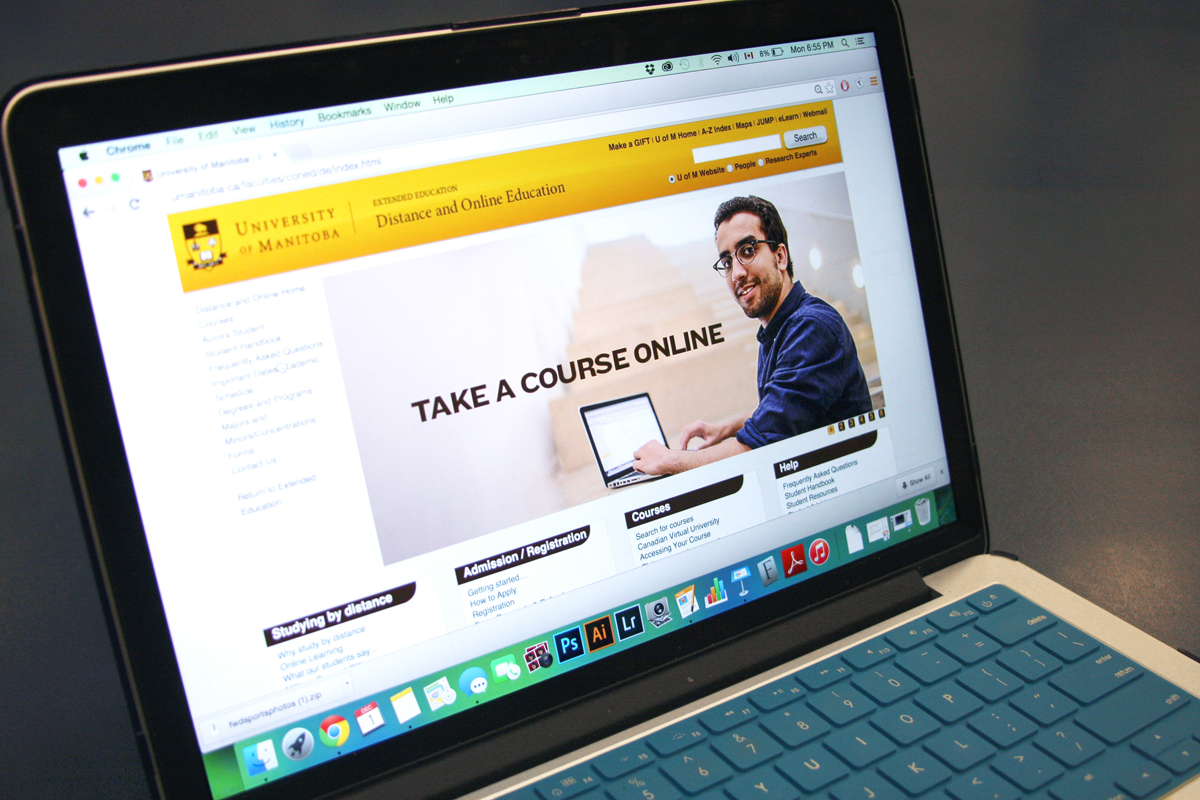At last month’s throne speech the provincial NDP announced a number of policies to be implemented in the coming year. While interest-free student loans have been heralded as a major treat for post-secondary students, a number of other policies that will affect students have been proposed. Among those is a two-fold increase in the number of courses to be offered online – from 500 to 1,000 across the province.
“We will build on the significant steps taken over the last decade to ensure post-secondary education is accessible and affordable,” said Premier Greg Selinger in a speech to media on Nov. 20.
Enrolment in online courses is already on the rise at the University of Manitoba. In the 2013/14 academic year, 9,318 U of M students were registered for online courses. That represents a 42 per cent increase from 2009/2010, when 6,547 students were registered for online courses.
In 2013/14, 151 online degree credit courses were offered across 12 faculties and 28 departments.
Extended education at the U of M, which oversees distance and online education, does not have access to the number of students who graduate either entirely or primarily through online courses.
Currently, U of M students may complete their bachelor of arts, bachelor of arts in geography, bachelor of social work, or post-baccalaureate diploma in education by taking distance and online education courses.
Students completing their bachelor of arts with distance and online education are able to major in Canadian studies, criminology, economics, English, geography, history, philosophy, political studies, psychology, and sociology.
Students who live in the city must come to the Fort Garry campus to write their exams as a component of online courses that have final exams. Students who do not live within city limits are not required to visit the campus; another location is selected.
Lynette Phyfe, interim director of distance and online education, told the Manitoban that online courses provide greater flexibility for students when it comes to time management.
“Courses that are taken through online delivery provide students flexibility for their schedule, location, and program completion.”
Canadian Association of University Teachers on distance education
The Canadian Association of University Teachers released a policy statement, last revised in 2009, which outlines its position on distance education.
“[The Canadian Association of University Teachers] is dedicated to the removal of barriers that traditionally restrict access to and success in post-secondary institutions and to increasing equality and equity of educational opportunity for all Canadians.
“Distance education is one medium that allows post-secondary educational institutions to pursue these goals. Post-secondary institutions’ employers may nonetheless misuse distance education techniques to increase managerial control over academic staff and/or as a way to save money.”
The statement also lists a number of items that faculty associations should ensure are included in contract language as part of an effort to maintain a high-quality level of education.
These points include that “adequate time and resources are available to learn to use new computer technologies and distance education techniques”; “courses shall be taught by fully qualified staff”; and “academic staff have the right to determine the method of course delivery.”
The Canadian Association of University Teachers’ member associations include faculty associations from across Canada. Locally, these include the University of Manitoba Faculty Association, the Brandon University Faculty Association, the University of Winnipeg Faculty Association, the St. John’s College Faculty Association, the Association des professeur(e)s de l’Université de Saint-Boniface, and the Manitoba Organization of Faculty Associations.
Local voices look at online courses
David Camfield, associate professor of labour studies and sociology at the U of M, was critical of the proposed increase in online courses being offered in the province.
“Expanding access to post-secondary education is a good thing. However,” Camfield continued, “I also have concerns about the quality of education. Not all courses are equally suitable for offering online. In-person classes with small class sizes offer unique opportunities for learning. We need more of them; but, because of budget cuts, there are fewer of them available to students.
“Many of the new online courses will no doubt be taught by sessional instructors who are paid less than tenure-stream faculty, with little or no job security and weaker academic freedom protection. That’s a problem.”
Zach Fleisher, chairperson for the Canadian Federation of Students-Manitoba, shared some of Camfield’s concerns. However, Fleisher said that if the courses were used to help rural and distance students, then it would be a benefit to post-secondary students.
“I’m often wary about the usage of online courses on university campuses as there are concerns regarding the ‘mass production’ of education, which could theoretically lead in turn to less professors and offerings. In my personal experience as a student, I’ve often leaned towards the in-classroom experience.
“My understanding around the provincial throne speech and online courses is that the new offerings will primarily be targeted towards rural and distance students, in which case this is a positive development for extending education to those who don’t always have access.”
Fleisher noted that specifics in implementing the plan were not yet available and said that he would be monitoring its execution.
“I don’t have the exact information on how these new developments for online courses are taking place. Traditionally, the university would have jurisdiction on classes on its own campus, so we’ll have to keep an eye on this proposal as it develops.”
Student experiences
Danielle Murphy, U of M human nutritional sciences student in the faculty of agriculture and food sciences, said she had some difficulty the first time she took an online course.
“I took Statistics 1000 online for about a month before the first midterm; then I ended up dropping it.
“It was easier to teach myself, but I found it was really hard to discipline myself to study. I was always studying for my other courses that [took place in a classroom] because it would remind me what I had to do in the classes; whereas online, I had to remind myself, so I found that really hard. So I ended up just taking it [the next semester] in an actual classroom with a professor instead.”
Murphy said she did better when she took the course on campus the following semester, but that she would still recommend online courses to other people.
“I would [recommend it] – because my roommate actually took a couple of online courses this summer and she really, really liked them. Because she felt that she could just go home and work still, while she had the convenience of doing school.”
Sabine Hergenreiter, a U of M student taking prerequisites for nursing, has also taken online courses in the past.
“I tried like three years ago, but I didn’t find it was something for me so I dropped the course.
“I found it really confusing at first actually and I had to talk to my sister and she helped me a little bit,” Hergenreiter continued, “But I found that I wasn’t able to concentrate really [well]—just at home I guess—so I like the classroom setting way better.”
Hergenreiter was less willing to recommend online courses to a friend.
“I guess it’s convenient, but I really wouldn’t want to do it again.”
For more information about online courses offered at the U of M, check distance and online education’s website: umanitoba.ca/faculties/coned



